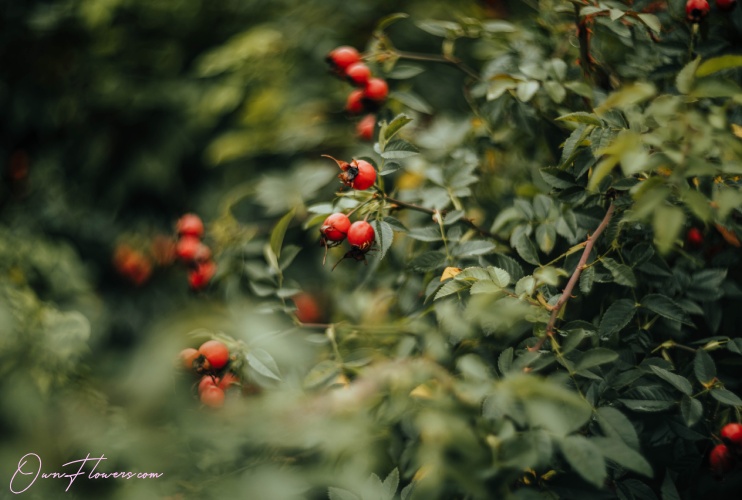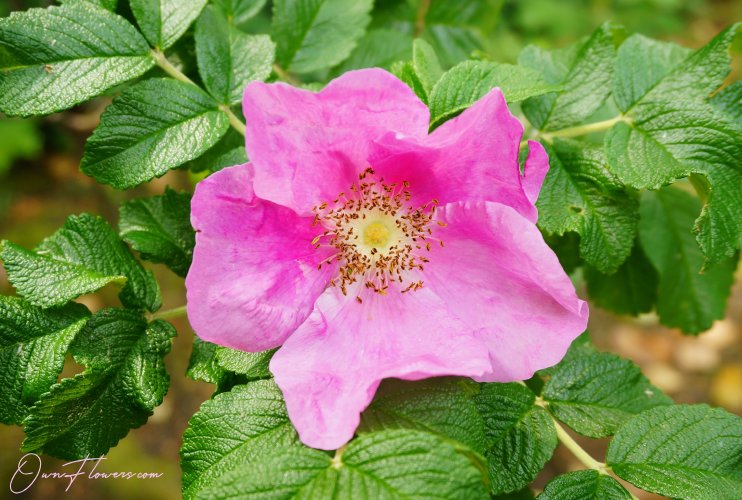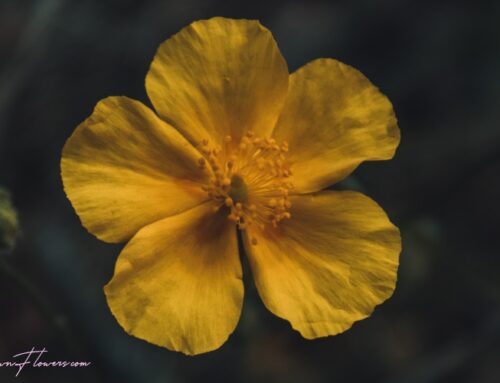Overview:
Rosa Canina, also known as Dog rose, is a deciduous shrub that is native to Europe, northwest Africa, and western Asia. This hardy plant species, the wild rose, can climb up to 16 feet in height, and its arching stems have small thorns covering them. Dog roses produce showy flowers in late spring, followed by small, glossy, red-orange fruits called rose hips.
You can grow the dog rose as a versatile plant, either as a hedge, standalone or as part of a wild hedge. It is easy to care for and can thrive in all types of soil, making it a popular choice for gardeners. However, its aggressive growth habit can make it invasive in some areas, so it is important to monitor its growth and prevent it from overtaking other desired plants in the garden. In this article, we will explore the characteristics of the dog rose, how to grow and care for it, and its various uses in landscaping and herbal medicine.
Dog Rose:
Dog rose (Rosa canina) is a deciduous shrub that belongs to the rose family. The wild rose species that is native to Europe, North Africa, and West Asia produces many arching stems covered in small thorns. Additionally, the shrub has toothed leaves that are a medium green color.
In late spring, showy flowers appear, which are pink or white in color. In the autumn, small, oval, glossy, red-orange fruits, also known as rose hips, follow these flowers. People often use the edible rose hips to make jams, jellies, and teas.
Dog rose is a hardy shrub. People often grow it as a hedge because it grows vigorously and can climb up other shrubs or trees. It prefers sunny to semi-shady locations and requires well-drained soil.
People often plant the dog rose in gardens and use it in cottage gardens and wildflower meadows because it is popular. It is also an important plant for wildlife, providing food and shelter for birds and insects.
Overall, dog rose is a beautiful and hardy shrub that is easy to grow and care for. Its showy flowers and edible rose hips make it a popular choice for gardens and landscapes.
Botanical Description:
Dog rose, or Rosa canina, is a climbing wild rose species that is native to Europe, northwest Africa, and western Asia. This deciduous shrub can grow up to 16.4 feet in height, but sometimes it can scramble higher into the crowns of taller trees. It has multiple arching stems covered with stout, curved thorns and pinnately divided, serrated, mid-green leaves.
The flowers of the dog rose typically bloom in June and July, emitting a sweet scent, and they are usually pink or white.In the autumn, birds and small mammals, such as bank voles, often eat the bright red rosehips that follow them.

Ownflowers.com
The species name of the dog rose, “canina,” means “with sharp teeth or thorns” (much like a dog’s teeth). Indeed, this shrub possesses very sharp, stout, curving thorns, which make it a tough and fast-growing plant. It was introduced to North America from Europe, where it extends from Norway all the way to southwest Asia.
Dog rose is planted as an ornamental plant in landscaped settings in the U.S. and Canada. Moreover, it adds beauty to these landscapes. However, it has escaped cultivated gardens and become problematic in natural areas. It is important to be cautious when planting dog rose in your garden and to prevent it from spreading into nearby natural areas.
Habitat And Distribution:
Native Regions:
Dog rose, also known as Rosa canina, grows wild in Europe, northwest Africa, and western Asia. Commonly, people find it in hedgerows, woodland edges, sand dunes, and grasslands. In central Britain and Ireland, it abounds, while in coastal areas, it is generally less visible. A similar species, the low-growing Burnet, is found in coastal areas as well.
Global Spread:
The species, introduced from Europe to North America, where it ranges from Norway to southwest Asia, grows rapidly to a height of 9 feet. Additionally, Dog rose is found in other parts of the world, such as Australia, New Zealand, and South America.
Dog rose is a very adaptable plant and can grow in a variety of habitats, including forests, meadows, and rocky slopes. It prefers well-drained soils and can tolerate a range of pH levels. It is also drought-tolerant and can survive in areas with low rainfall.
In conclusion, the dog rose, which can grow in various habitats, is a widely distributed species. Its adaptability and hardiness make it a popular choice for landscaping and as a medicinal plant.
Cultural Significance:
Symbolism:
Dog Rose occupies a significant place in many cultures around the world. Transitioning to the realm of spirituality, people believe that it symbolizes love, protection, and divine guidance. Moreover, they often associate the flower with the heart chakra and believe that it aids in opening up the heart to love and compassion. In addition, some cultures view the flower as a symbol of secrecy and confidentiality.
Use In Folklore:
Dog Rose has been a part of folklore and traditional beliefs for centuries. In ancient Greece, the flower was dedicated to the goddess Aphrodite and was believed to have the power to bring love and beauty into one’s life. Norse mythology associates the flower with the goddess Freya, believing it to possess healing properties.
In some cultures, the flower also associates death and the underworld. In Celtic mythology, people believed that the dog rose served as a portal to the fairy world. They thought that passing through the rose bush would transport someone to the fairy world. Additionally, certain cultures believe that the flower offers protection against evil spirits and negative energies.
In conclusion, Dog Rose holds significant cultural significance and has been a part of folklore and traditional beliefs for centuries. Its symbolism and use in various cultures around the world make it a unique and fascinating flower.
Cultivation And Care:
Planting Guidelines:
When it comes to planting dog roses, there are a few things to keep in mind to ensure that they thrive. First, choose a sunny location with well-draining soil. Dog roses prefer slightly acidic soil with a pH between 6.0 and 6.5. If your soil is too alkaline, you can lower the pH by adding sulfur or peat moss.
When planting, dig a hole that is twice as wide and deep as the root ball. Gently loosen the roots and place the plant in the hole, making sure that the top of the root ball is level with the soil surface. Backfill the hole with soil, pressing it firmly around the roots. Water thoroughly to settle the soil and help the roots establish.
You can also grow dog roses from cuttings or seeds. If propagating from cuttings, take a 6- to 8-inch cutting from a healthy stem in late summer or early fall. Remove the leaves from the bottom half of the cutting and dip the cut end in rooting hormone. Plant the cutting in a pot filled with moist potting soil and keep it in a warm, bright location until roots form.
Maintenance Tips:
Dog roses are relatively low-maintenance plants, but there are a few things you can do to keep them healthy and looking their best. Here are some maintenance tips to keep in mind:
By following these planting and maintenance guidelines, you can enjoy beautiful, healthy dog roses in your garden for years to come.
Medicinal Properties:
Traditional Uses:
Dog rose has a long history of use in traditional medicine. For centuries, people have used it to treat a variety of ailments, including digestive issues, respiratory problems, and skin conditions. The plant’s fruit, known as rose hips, has been particularly valued for its high vitamin C content.
Rose hips serve multiple purposes, such as making tea, syrup, and other remedies to boost the immune system and fight off infections. Additionally, they function as a natural remedy for arthritis due to their anti-inflammatory compounds, which can effectively reduce pain and swelling.

Ownflowers.com
Additionally, the plant has treated skin conditions like eczema and psoriasis. Moreover, people have used the oil extracted from the seeds of the dog rose topically to soothe and moisturize dry, irritated skin.
Modern Research:
Modern research has confirmed many of the traditional uses of dog rose. Studies have shown that rose hips are indeed a rich source of vitamin C, as well as other beneficial compounds such as carotenoids, flavonoids, and essential fatty acids.
Research has also shown that rose hips have potent antioxidant and anti-inflammatory properties, which may help protect against chronic diseases such as heart disease, cancer, and diabetes. In addition, studies have shown that rose hips may help improve immune function and reduce the risk of infections.
Overall, while much of the traditional use of dog rose has been supported by modern research, more studies are needed to fully understand the plant’s potential medicinal properties. However, given its long history of use and its rich nutritional profile, dog rose is certainly a plant worth exploring further for its potential health benefits.
Ecological Impact:
Dog rose (Rosa canina) is a plant species that has a significant ecological impact. It is a wild rose that grows in many parts of the world, including Europe, Asia, and North America. Dog rose boasts attractive flowers and edible fruit, rich in vitamin C; nevertheless, it also carries several ecological impacts worth considering.
Wildlife Attraction:
Dog rose serves as a valuable source of food for many wildlife species. Birds, small mammals, and insects consume its fruit. Additionally, the flowers allure pollinators like bees and butterflies. Moreover, the plant offers shelter and nesting sites for birds and small mammals.
Environmental Considerations:
Despite its ecological benefits, dog rose can also have negative environmental impacts. It can spread rapidly and outcompete native plant species, leading to a loss of biodiversity. In South Australia, community groups actively manage dog rose, considering it a significant environmental weed.
Dog rose can also have an impact on soil erosion. Its deep root system helps to stabilize soil, but the plant’s dense growth can also contribute to erosion in some cases.
Overall, dog rose has both positive and negative ecological impacts. While it provides valuable food and habitat for wildlife, it can also contribute to biodiversity loss and soil erosion. It is important to consider these impacts when managing dog rose populations and incorporating the plant into various uses







Leave A Comment
You must be logged in to post a comment.